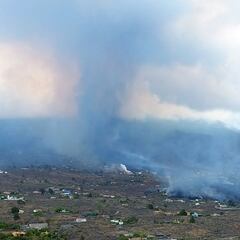La Palma volcano: what will happen when the lava reaches the Atlantic Ocean?
As the lava from the La Palma eruption causes destruction as it advances toward the coast, there are worries about new dangers once it arrives to the ocean.

The Cumbre Vieja volcanic eruption that began Sunday on the island of La Palma in the Canary Islands has been spewing lava relentlessly since. The Lava flow, which initially had a flow rate of 700 meters per hour, was expected to reach the Atlantic Ocean Monday evening but the river of lava slowed considerably when it reached flatter terrain.
Experts monitoring the eruption don’t know how long the eruption will last but it could go on for weeks or even months. The fissure which the lava is flowing from is just over three miles (5.2 km) from the ocean. With its proximity to the sea officials are preparing for what happens then.
Also see:
- La Palma volcano eruption: live updates
- How many active volcanoes are there in the Canary Islands?
- Where are the Canary Islands on a map? Who owns the islands?
- When was the last time there was a volcanic eruption in the Canary Islands?
- Homes destroyed in Canary Island volcanic eruption
Authorities concerned about the reaction of lava with seawater
The lava flow has split into two streams, one heading inland and the other advancing toward the coast, albeit much slower than when the volcanic eruption started. The scientific organizations that are monitoring the eruption predict the lava will enter the sea on the coast of Tazacorte, most likely at Playa del Perdido or Playa Nueva.
Once the lava reaches the seawater authorities are concerned about the reaction of the two elements when they come into contact. According to the emergency management team there could be explosions from thermal shock as the lava has a temperature of around 1,800 ºF (1,100ºC) and the seawater just 73ºF (23ºC). The mixture of the molten rock and the seawater will also lead to chemical reactions that will present additional dangers.
#EUSpace for #LaPalmaEruption@CopernicusEMS is working 24/7 to support those involved in the🌋emergency ongoing in #LaPalma
— 🇪🇺 DG DEFIS #StrongerTogether (@defis_eu) September 22, 2021
Last night a new map was released showing that the lava extent has reached 154.4ha
More🔗https://t.co/GWEI0ERXt8
Our thoughts are with those affected pic.twitter.com/Giu1wb5Y50
Glass shards and corrosive gases
The thermal shock besides boiling the water will cause the molten rock to shatter into fine grains of volcanic glass that will be carried in the billowing steam clouds. Additionally, the steam clouds will contain hydrochloric acid gas formed by the interaction of the lava and saltwater. This gas will have the corrosive effect of diluted battery acid according to the USGS, which can irritate the skin, eyes and respiratory system.
There will be explosions. It's like mixing boiling oil with water.
José Mangas, professor of Geology at the University of Las Palmas
This combination is called “laze” or lava haze and it can be carried back on shore where it should be avoided. “Acid rain can be generated, causing throat and nose irritations to the public,” said José Mangas, professor of Geology at the University of Las Palmas.
The authorities have established a two-mile nautical exclusion zone for boats which runs parallel to the coast from Las Viñas beach in the north to Puerto Naos in the south. Shipping vessels have also been advised to stay well clear of the area considered at risk.
Current update on the eruption in La Palma from @CopernicusEMS https://t.co/VTTef8J7QR
— Itahisa Gonzalez Alvarez (@seismowaves) September 21, 2021
Possibility of coast falling into the sea
Related stories
As the lava advances more slowly, the flow has begun to stack up higher towering nearly 40 feet (12 meters) high in places. These walls of molten rock are engulfing everything in their path. When they reach the shore unstable newly formed land along the coast could fall into the sea.
After the lava has superheated the surrounding water, new portions plunging into the sea could send waves of scolding hot water back onto shore. The exact time when the lava will reach the sea, if ever, hasn’t been determined but those monitoring the developing natural disaster are keeping a close eye on the situation.


